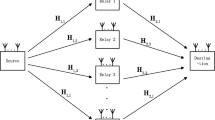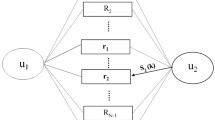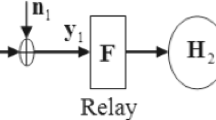Abstract
In this paper, we consider the precoder design at both the source and relay nodes of MIMO relay networks to minimize the symbol error rate (SER) based on the statistical channel state information. First compact SER expressions are derived, then the optimization problem of designing the precoding matrices is formulated. This problem is highly nonlinear and nonconvex. We propose a two-step method by exploiting the correlations of the source-relay and relay-destination links. In the first step the two precoding matrices are proved to be in the eigenvector directions of the transmit correlation matrices. In the second step, the original joint problem is decomposed into two independent sub-problems which can be solved in lower complexity. Simulation results show that the precoding system combined with orthogonal space–time block codes (STBC) outperforms the STBC-only system in terms of SER, especially at low signal-to-noise ratios.






Similar content being viewed by others
References
Alamouti, S. M. (1998). A simple transmit diversity technique for wireless communications. IEEE Journal on Selected Areas in Communications, 16(8), 1451–1458.
Jöngren, G., Skoglund, M., & Ottersten, B. (2002). Combining beamforming and orthogonal space-time block coding. IEEE Transactions on Information Theory, 48(3), 611–627.
Zhou, S., & Giannakis, G. B. (2002). Optimal transmitter eigen-beamforming and space-time block coding based on channel mean feedback. IEEE Transactions on Signal Processing, 50(10), 2599–2613.
Sampath, H., & Paulraj, A. (2002). Linear precoding for space-time coded systems with known fading correlations. IEEE Communications Letters, 6(6), 239–241.
Ekbatani, S., & Jafarkhani, H. (2008). Combining beamforming and space-time coding using quantized feedback. IEEE Transactions on Wireless Communications, 7(3), 898–908.
Hjørungnes, A., Gesbert, D., & Akhtar, J. (2006). Precoding of space-time block coded signals for joint transmit-receive correlated mimo channels. IEEE Transactions on Wireless Communications, 5(3), 492–497.
Hjørungnes, A., & Gesbert, D. (2007). Precoding of orthogonal space-time block codes in arbitrarily correlated mimo channels: iterative and closed-form solutions. IEEE Transactions on Wireless Communications, 6(3), 1072–1082.
Bhatnagar, M. R., & Hjørungnes, A. (2010). Linear precoding of STBC over correlated ricean MIMO channels. IEEE Transactions on Wireless Communications, 9(6), 1832–1836.
Ganesan, S., Liu, W., & Sellathurai, M. (2009). Limited feedback precoding for distributed space-time coding in wireless relay networks. In Proceedings international conference on wireless communications and signal processing (WCSP), pp. 1–5.
Suraweera, N. D., & Wavegedara. K. C. B. (2011). Distributed beamforming techniques for dual-hop decode-and-forward mimo relay networks. In Proceedings of 6th IEEE international conference on industrial and information systems (ICIIS), pp.125–129.
Chalise, B. K., Zhang, Y. D., & Amin, M. G. (2012). Precoder design for OSTBC Based AF MIMO relay system with channel uncertainty. IEEE Signal Processing Letters, 19(8), 515–518.
Paulraj, A., Nabar, R., & Gore, D. (2003). Introduction to space-time wireless communications. Cambridge: Cambridge University Press.
Simon, M. K., & Alouini, M. S. (2000). Digital communication over fading channels: A unified approach to performance analysis. New York: Wiley.
Oestges, C., & Clerckx, B. (2010). MIMO wireless communications—From real-world propagation to space-time code design. United Kingdom: Academic Press of Elsevier.
Olabiyi, O., & Annamalai, A. (2011). ASER analysis of cooperative non-regenerative relay systems over generalized fading channels. In Proceedings of 20th international conference on computer communications and networks (ICCCN), pp. 1–6.
Acknowledgments
This work is supported by the Zhejiang Open Foundation of the Most Important Subjects (xkxl1303 and xkxl1402) , by the Opening Fund of Top Key Discipline of Computer Software and Theory in Zhejiang Provincial Colleges at Zhejiang Normal University (ZC323014101),by the Research Project of Department of Education of Zhejiang Province (Y201224625) and by the Zhejiang Provincial Natural Science Foundation (LQ13F020008).
Author information
Authors and Affiliations
Corresponding author
Appendices
Appendix 1: Proof of Proposition 1
Proof
A tight approximation for the moment generating function (MGF) of the output SNR is given by [15]
where the MGF is defined as \( M_{{\gamma_{i} }} (s) \triangleq \int_{0}^{\infty } {f_{{\gamma_{i} }} } (\gamma_{i} )e^{{ - s\gamma_{i} }} d\gamma_{i} \). It follows from [7] that ψ i can be written as the weighted sum of the square of the absolute value of independent complex Gaussian variables. By using the eigen-decomposition of \( {\mathbf{L}}_{i} \), the moment generating function of ψ i is given by\( M_{{\psi_{i} }} (s) = \prod\nolimits_{j = 1}^{{M_{i,t} M_{i,r} }} {(1 + \lambda_{j} ({\mathbf{L}}_{i} )s)^{ - 1} = \det ({\mathbf{I}} + {\mathbf{L}}_{i} s)^{ - 1} } \), where \( \lambda_{j} ({\mathbf{L}}_{i} ) \) is the jth eigenvalue of the positive semi-definite matrix \( {\mathbf{L}}_{i} \) for i = 1, 2. M 1,t = M S , M 1,r = M 2,t = M R and M 2,r = M D are the number of antenna transmitter and receiver respectively. Using (22) and γ i = ψ i /σ 2 i .σ 2 i as shown in (8) and (11), the moment generating function of the approximate \( \tilde{\gamma }_{SNR} \) can be calculated as
Using the result in (23), the SER of the relay system for both the MPSK and MPAM modulation can be expressed as
Then we can get the approximate expression in (14). The derivation for the MQAM can be done in (15) similarly. This completes the proof of Proposition 1.
Appendix 2: Proof of Proposition 2
Proof
First, the Lemma 1 is helpful for deriving the main result.
Lemma 1
For two non-negative independent random variables x 1 and x 2 with x 1 , x 2 ∊ (0, 1), the function f(x 1 , x 2 ) = x 1 + x 2 − x 1 x 2 is a monotonically increasing function.
Proof
Take partial derivative of f(x 1, x 2)with respect to x 1 and x 2, we have \( \frac{{\partial f(x_{1} ,x_{2} )}}{{\partial x_{1} }} = 1 - x_{2} \) and \( \frac{{\partial f(x_{1} ,x_{2} )}}{{\partial x_{2} }} = 1 - x_{1} \). When x 1, x 2 ∊ (0, 1), the function is increasing monotonically. So f(x 1, x 2) is minimized when x 1 and x 2 are minimized.
Proof of Proposition 2
Let \( {\mathbf{X}}_{1} (\theta ) \), \( {\mathbf{X}}_{2} (\theta ) \) be positive definite matrices for arbitrary θ ∊ [θ 1, θ 2]. Definite the operator \( D({\mathbf{A}}) \): return a diagonal matrix whose diagonal elements is consistent with the diagonal elements of original matrix A. For all θ ∊ [θ 1, θ 2], it follows from [7] that
where the equality is achieved if and only if \( {\mathbf{X}}_{1} (\theta ) \) and \( {\mathbf{X}}_{2} (\theta ) \) are diagonal. For \( {\text{det}}^{{ - 1}} ({\mathbf{X}}_{1} (\theta )) \) and \( {\text{det}}^{{ - 1}} ({\mathbf{X}}_{2} (\theta )) \in \left( {0,1} \right) \), using Lemma 1, we have
By considering integrals as a sum, the following inequality holds for all θ ∊ [θ 1, θ 2] [7].
The equality is achieved if and only if \( {\mathbf{X}}_{1} (\theta ) \) and \( {\mathbf{X}}_{2} (\theta ) \) are all diagonal matrices. So the SER is minimized when \( {\text{det}}^{{ - 1}} (D({\mathbf{X}}_{1} (\theta ))) \) and \( {\text{det}}^{{ - 1}} (D({\mathbf{X}}_{2} (\theta ))) \) are minimized at the same time, and it is equal to that their reciprocals are maximized. Assume that the correlation matrices have the following eigen-decomposition: \( {\mathbf{R}}_{i,t} = {\mathbf{U}}_{{{\mathbf{R}}_{i,t} }} \Lambda_{{{\mathbf{R}}_{i,t} }} {\mathbf{U}}_{{{\mathbf{R}}_{i,t} }}^{H} \),\( {\mathbf{R}}_{i,r} = {\mathbf{U}}_{{{\mathbf{R}}_{i.r} }} \Lambda_{{{\mathbf{R}}_{i,r} }} {\mathbf{U}}_{{{\mathbf{R}}_{i,r} }}^{H} \). It follows from [7] that \( {\mathbf{L}}_{i} \) in the integral of the SER can be rewritten as
where \( {\text{det}}^{{ - 1}} ({\mathbf{I}}_{{M_{i,t} M_{i,r} }} + {\mathbf{L}}_{i} g/\sigma_{i}^{2} \sin^{2} \theta ) \in \left( {0,1} \right) \). From (28) and (29), it is seen that the SER is minimized when \( \Lambda_{{{\mathbf{R}}_{i,t} }}^{1/2} {\mathbf{U}}_{{{\mathbf{R}}_{i,t} }}^{T} {\mathbf{W}}_{i}^{ * } {\mathbf{W}}_{i}^{T} {\mathbf{U}}_{{{\mathbf{R}}_{i,t} }}^{ * } \Lambda_{{{\mathbf{R}}_{i,t} }}^{1/2} \) is diagonalized. Therefore the precoding matrices must satisfy
where \( {\mathbf{E}}_{{{\mathbf{W}}_{i} }} \) is a diagonal matrix. So the optimal direction is along the eigenvectors of the transmit correlation matrices. This completes the proof of Proposition 2.
Appendix 3: Proof of Proposition 3
Proof
Since the directions of the precoding matrices have been decided, (29) can be further expressed as follows
We define \( g_{{\theta_{i} }} ({\mathbf{W}}_{i} ) \triangleq \prod\limits_{m = 1}^{{M_{i,r} }} {\prod\limits_{n = 1}^{{M_{i,t} }} {\left( {1 + (g/\sigma_{i}^{2} \sin^{2} \theta ) \cdot \lambda_{m} ({\mathbf{R}}_{i,r} )\lambda_{n} ({\mathbf{R}}_{i,t} )\lambda_{n} ({\mathbf{P}}_{{{\mathbf{W}}_{i} }} )} \right)} } \), then (24) can be rewritten as
Notice that (32) is increasing monotonically with θ, so the maximum of integral is achieved when θ is equal to pi/2 for \( \forall {\mathbf{W}}_{1} ,{\mathbf{W}}_{2} \).Then the value of SER is equivalent to the special rectangular area as follows
Assuming \( g_{{\theta_{i\hbox{max} } }} ({\mathbf{W}}_{i} ) = \prod\nolimits_{m = 1}^{{M_{i,r} }} {\prod\nolimits_{n = 1}^{{M_{i,t} }} {\left( {1 + (g/\sigma_{i}^{2} \sin^{2} \theta_{\hbox{max} } ) \cdot \lambda_{m} ({\mathbf{R}}_{i,r} )\lambda_{n} ({\mathbf{R}}_{i,t} )\lambda_{n} ({\mathbf{P}}_{{{\mathbf{W}}_{i} }} )} \right)} } \), we have \( F(\theta_{\hbox{max} } ) = f(g_{{\theta_{1\hbox{max} } }}^{ - 1} ({\mathbf{W}}_{1} ),g_{{\theta_{1\hbox{max} } }}^{ - 1} ({\mathbf{W}}_{2} )) \). Since Δθ is a fixed value, (33) can be replaced with \( \hbox{min} P_{s} (error) = \begin{array}{*{20}c} {\hbox{min} } \\ \end{array} F(\theta_{\hbox{max} } ) \). From the proof of Proposition 2 we know that \( \begin{array}{*{20}c} {\hbox{min} } \\ \end{array} F(\theta_{\hbox{max} } ) \) can be converted to \( \begin{array}{*{20}c} {\hbox{max} } \\ \end{array} g_{{\theta_{1\hbox{max} } }} ({\mathbf{W}}_{1} ) \) and \( \hbox{max} g_{{\theta_{2\hbox{max} } }} ({\mathbf{W}}_{2} ) \). Because ln (·) is also a monotonically increasing function, so the optimization criteria can be divided into two sub-problems: \( \begin{array}{*{20}c} {\hbox{max} } \\ \end{array} \ln g_{{\theta_{1\hbox{max} } }} ({\mathbf{W}}_{1} ) \) and \( \begin{array}{*{20}c} {\hbox{max} } \\ \end{array} \ln g_{{\theta_{2\hbox{max} } }} ({\mathbf{W}}_{2} ) \) under the power constraints.
This completes the proof of Proposition 3.
Rights and permissions
About this article
Cite this article
Zhang, Y., Li, Y., Wang, G. et al. Precoding of Space–Time Block Codes for Relay Networks over Correlated MIMO Channels. Wireless Pers Commun 84, 1387–1400 (2015). https://doi.org/10.1007/s11277-015-2693-7
Published:
Issue Date:
DOI: https://doi.org/10.1007/s11277-015-2693-7




